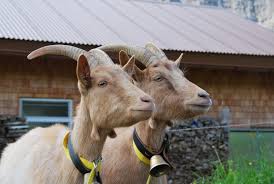The drawing of lots in the times of the Beis Hamikdosh for the Yom Kippur ritual of the “shenei se’irim” – the “two goats,” undoubtedly commanded the rapt attention of all present.
Two indistinguishable members of that species were brought before the Kohen Gadol, who placed a randomly-pulled lot on the head of each animal. One lot read “to Hashem” and the other “to Azazel” – the name, according to many meforshim, of a steep cliff in a barren desert.
The first goat, as we all know, was solemnly brought as a korban, attention given to every detail of the offering, as with any other; and the second was taken to the cliff and thrown off, dying unceremoniously before even reaching the bottom.
The law of the shenei se’irim is a chok, its deepest meanings beyond our understanding. But pondering it before Yom Kippur, and as we recall it in the day’s Mussaf, might still yield food for thought and, more important, for inspiration.
Human beings have two choices when it comes to how they view themselves. Some, in the past as in the present, understand that our minds and free will are clear evidence of Divine intent; others choose to see our existence as an accident. The former see human life as meaningful; the latter, as not.
If we’re the product of randomness, there can be no more meaning to good and bad actions than to good or bad weather; no more import to right and wrong than to right and left. Human beings remain but advanced animals, tzaddikim and resha’im alike. Yes, people can create societal expectations and norms, but a social contract is only a practical tool, not a moral imperative; it is, in the end, artificial. Only with a Creator in the larger picture can there be ultimate import to human life, placing it on a plane meaningfully above that of monkeys or mosquitoes.
The Torah, of course, is based on – and in fact begins with an account of – a Divinely directed creation; and its most basic message is the meaningfulness of human life.
Every human being, if his consciousness is unclouded by base desires and cynicism, possesses a similar innate conviction.
Yet many resist that inherent understanding, and adopt the perspective that all that there is in the end is what we can perceive with our physical senses, that how we act makes no ultimate difference. They point to the existence of evil and the Creator’s invisibility as their “proofs.” Their excuses.
Could those diametric worldviews be reflected in the se’irei Yom Kippur?
The sa’ir that becomes a korban on the mizbei’ach might symbolize recognition of the idea that we are beholden to something greater than ourselves. And the counter-goat, which finds its fate in a desolate, unholy place, might allude to the perspective of life as pointless, lacking higher purpose or meaning.
Consider, further, the fact that the Torah, strangely, describes the Azazel-goat as carrying away the sins of the people (Vayikra 16: 22).
The meforshim all wonder at that concept. Some, including the Rambam, interpret it to mean that the people will be stirred by the dispatching of the Azazel-goat to repent (Moreh Nevuchim 3:46).
How the Azazel-goat’s being “laden with the sins” of the people could serve as an inspiration might be understandable, though, if it indeed subtly alludes to the mindset of meaninglessness.
Because chet ultimately stems from insufficient recognition of how meaningful our lives are. Reish Lakish in fact said as much when he observed (Sotah 3a) that “A person does not sin unless a spirit of madness enters him.” The madness, perhaps, of seeing himself as ultimately meaningless. That meaninglessness certainly provides ample reason to not care about one’s actions.
And so the sending forth of the Azazel-goat to its haphazard death could be seen as an acknowledgement of the idea that the roots of chet lie in that madness born of self-doubt. And those who witnessed its dispatching might well then have been spurred by that thought to consider the goat’s counterpart, the animal brought on the mizbe’ach in dedication to Hashem. And, so moved on the holiest day of the year, they might then have been spurred to re-embrace the grand meaningfulness that is a life of bechirah bachaim.
By recounting that scene, and picturing the se’irim on Yom Kippur, we, too, might access the same eternally timely thought. And resolve thereby to merit a gmar chasimah tovah.
© 2017 Hamodia
